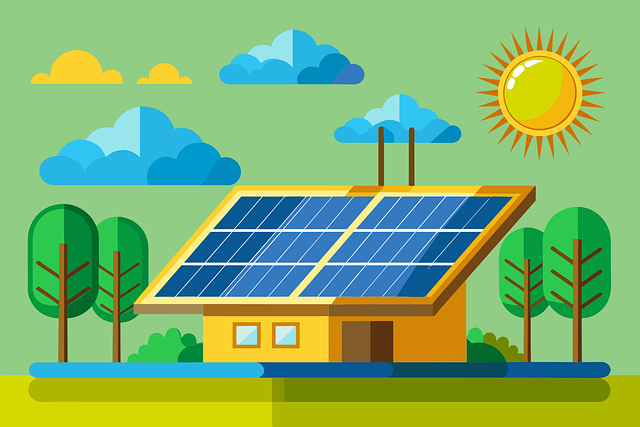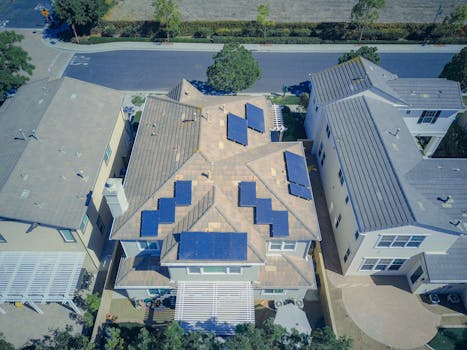“Empower Your Energy: Seamlessly Integrate Solar Inverters with Battery Storage for a Sustainable Future.”
Integrating a solar inverter with battery storage systems is a pivotal advancement in renewable energy technology, enabling efficient energy management and enhanced sustainability. This integration allows for the storage of excess solar energy generated during peak sunlight hours, which can be utilized during periods of low solar production or high energy demand. By combining solar inverters with battery storage, users can achieve greater energy independence, reduce reliance on the grid, and optimize energy consumption. This synergy not only maximizes the benefits of solar power but also contributes to a more resilient and reliable energy infrastructure, paving the way for a cleaner and more sustainable future.
Benefits Of Integrating Solar Inverters With Battery Storage
Integrating solar inverters with battery storage systems presents a transformative opportunity for both residential and commercial energy users. This synergy not only enhances energy efficiency but also contributes to a more sustainable energy future. One of the primary benefits of this integration is the ability to store excess energy generated during peak sunlight hours. When solar panels produce more electricity than is immediately needed, the surplus can be directed to charge batteries. This stored energy can then be utilized during periods of low sunlight or high demand, effectively reducing reliance on the grid and lowering electricity bills.
Moreover, the combination of solar inverters and battery storage systems provides a level of energy independence that is increasingly sought after in today’s volatile energy market. By harnessing solar energy and storing it for later use, homeowners and businesses can mitigate the impact of fluctuating energy prices and potential power outages. This independence not only enhances energy security but also fosters a sense of control over one’s energy consumption. As a result, users can better manage their energy needs, leading to more predictable budgeting and reduced financial stress.
In addition to financial benefits, integrating solar inverters with battery storage systems contributes significantly to environmental sustainability. By maximizing the use of renewable energy, this integration reduces the carbon footprint associated with traditional energy sources. When users rely more on stored solar energy, they decrease their dependence on fossil fuels, which are often responsible for greenhouse gas emissions. This shift not only benefits individual users but also contributes to broader efforts aimed at combating climate change. As more people adopt this technology, the cumulative effect can lead to a substantial reduction in overall carbon emissions.
Furthermore, the integration of solar inverters and battery storage systems enhances the resilience of the energy grid. During peak demand periods, when the grid is under stress, stored solar energy can be fed back into the grid, helping to stabilize it. This not only supports the grid’s reliability but also allows users to take advantage of net metering programs, where they can receive compensation for the energy they contribute back to the grid. This creates a win-win situation, as it encourages the use of renewable energy while providing financial incentives for users.
Another significant advantage of this integration is the technological advancements that have made these systems more efficient and user-friendly. Modern solar inverters are equipped with smart technology that allows for real-time monitoring and management of energy production and consumption. This capability enables users to optimize their energy usage patterns, ensuring that they are making the most of their solar investment. Additionally, many battery storage systems now come with advanced features such as remote monitoring and control, allowing users to manage their energy resources from anywhere.
In conclusion, the integration of solar inverters with battery storage systems offers a multitude of benefits that extend beyond mere energy savings. By providing energy independence, enhancing environmental sustainability, supporting grid resilience, and leveraging advanced technology, this integration represents a significant step toward a more sustainable and efficient energy future. As the demand for renewable energy solutions continues to grow, embracing this integration will not only empower individual users but also contribute to a collective movement toward a cleaner, more sustainable planet.
Key Considerations For Choosing The Right Solar Inverter

When it comes to integrating a solar inverter with battery storage systems, selecting the right solar inverter is crucial for optimizing energy efficiency and ensuring a seamless operation. The inverter serves as the heart of the solar energy system, converting the direct current (DC) generated by solar panels into alternating current (AC) that can be used by household appliances. Therefore, understanding the key considerations for choosing the right solar inverter is essential for maximizing the benefits of solar energy and battery storage.
One of the primary factors to consider is the inverter type. There are several types of solar inverters available, including string inverters, microinverters, and power optimizers. String inverters are the most common and are typically used in residential installations. They connect multiple solar panels in a series, making them cost-effective and easy to install. However, if your installation has shading issues or varying panel orientations, microinverters or power optimizers may be more suitable. These options allow for individual panel management, enhancing overall system performance. Therefore, assessing your specific installation conditions is vital in determining the most appropriate inverter type.
Another important consideration is the inverter’s compatibility with battery storage systems. Not all inverters are designed to work seamlessly with batteries, so it is essential to choose an inverter that supports energy storage integration. Hybrid inverters, for instance, are specifically designed to manage both solar energy generation and battery storage, allowing for efficient energy use and storage. This capability enables homeowners to store excess energy generated during the day for use during peak demand times or at night, ultimately enhancing energy independence and reducing reliance on the grid.
In addition to compatibility, the inverter’s efficiency rating is a critical factor. The efficiency of a solar inverter indicates how well it converts DC electricity into AC electricity. Higher efficiency ratings mean less energy loss during the conversion process, which translates to more usable energy for your home. When comparing inverters, look for those with efficiency ratings above 95%, as this will ensure that you are maximizing the energy harvested from your solar panels.
Furthermore, the inverter’s power rating should align with your energy needs and the capacity of your solar panel system. The power rating, typically measured in kilowatts (kW), indicates the maximum amount of power the inverter can handle. It is essential to choose an inverter that can accommodate the total output of your solar panels while also considering future expansion possibilities. This foresight can save you from needing to replace the inverter if you decide to add more panels later.
Durability and warranty are also significant considerations when selecting a solar inverter. Inverters are exposed to various environmental conditions, so choosing a model with a robust design and a good warranty can provide peace of mind. Many manufacturers offer warranties ranging from five to ten years, with some premium models providing extended warranties of up to twenty years. A longer warranty often indicates a higher-quality product, which can lead to lower maintenance costs over time.
Lastly, it is advisable to consider the manufacturer’s reputation and customer support. Researching reviews and testimonials can provide insights into the reliability and performance of different inverter brands. A reputable manufacturer will not only offer a quality product but also provide excellent customer service and support, ensuring that any issues can be resolved promptly.
In conclusion, choosing the right solar inverter for integration with battery storage systems involves careful consideration of various factors, including inverter type, compatibility, efficiency, power rating, durability, and manufacturer reputation. By taking the time to evaluate these aspects, homeowners can ensure a successful solar energy system that meets their energy needs and contributes to a sustainable future.
How To Optimize Energy Management With Solar Inverters And Batteries
Integrating solar inverters with battery storage systems presents a transformative opportunity for optimizing energy management in residential and commercial settings. As the demand for renewable energy sources continues to rise, understanding how to effectively combine these technologies becomes essential for maximizing efficiency and sustainability. Solar inverters play a crucial role in this integration, converting the direct current (DC) generated by solar panels into alternating current (AC) suitable for household use. When paired with battery storage systems, these inverters not only enhance energy utilization but also provide a buffer against fluctuations in energy supply and demand.
To begin with, the synergy between solar inverters and battery storage systems allows for greater energy independence. During peak sunlight hours, solar panels generate excess energy that can be stored in batteries for later use. This stored energy can be particularly valuable during periods of high demand or when solar generation is low, such as at night or on cloudy days. By strategically managing this stored energy, users can reduce their reliance on the grid, thereby lowering electricity costs and minimizing their carbon footprint.
Moreover, optimizing energy management with solar inverters and batteries involves understanding the various modes of operation available. Many modern inverters come equipped with advanced features that allow users to prioritize energy usage based on their specific needs. For instance, some systems enable users to set preferences for charging the battery, using solar energy directly, or drawing from the grid. This flexibility ensures that energy is utilized in the most efficient manner possible, maximizing savings and enhancing overall system performance.
In addition to operational flexibility, integrating smart technology into solar inverter and battery systems can further enhance energy management. Smart inverters equipped with monitoring capabilities provide real-time data on energy production and consumption. This information allows users to make informed decisions about their energy usage patterns, enabling them to shift consumption to times when solar generation is at its peak. Furthermore, many systems can be controlled remotely via smartphone applications, allowing users to adjust settings and monitor performance from anywhere, thus ensuring optimal energy management at all times.
Another critical aspect of optimizing energy management is the consideration of battery capacity and type. Different battery technologies, such as lithium-ion and lead-acid, offer varying levels of efficiency, lifespan, and cost. Selecting the right battery type based on individual energy needs and usage patterns is essential for maximizing the benefits of the integrated system. Additionally, understanding the capacity of the battery in relation to the solar inverter’s output can help users avoid overcharging or deep discharging, both of which can negatively impact system performance and longevity.
Furthermore, regular maintenance and monitoring of both the solar inverter and battery system are vital for ensuring long-term efficiency. Routine checks can help identify potential issues before they escalate, allowing for timely repairs and adjustments. By maintaining optimal performance, users can ensure that their energy management system continues to operate at peak efficiency, providing reliable energy savings and sustainability benefits.
In conclusion, the integration of solar inverters with battery storage systems offers a powerful solution for optimizing energy management. By leveraging the capabilities of these technologies, users can achieve greater energy independence, reduce costs, and contribute to a more sustainable future. Through careful planning, smart technology integration, and regular maintenance, individuals and businesses can harness the full potential of their solar energy systems, paving the way for a cleaner and more efficient energy landscape.
Common Challenges In Solar Inverter And Battery Integration Solutions
Integrating a solar inverter with battery storage systems presents a range of challenges that can impact the efficiency and effectiveness of renewable energy solutions. As the demand for sustainable energy sources continues to grow, understanding these challenges becomes increasingly important for homeowners, businesses, and energy providers alike. One of the primary issues encountered during this integration process is the compatibility between the solar inverter and the battery system. Not all inverters are designed to work seamlessly with battery storage, and mismatches can lead to inefficiencies or even system failures. Therefore, selecting the right inverter that supports the specific battery technology—be it lithium-ion, lead-acid, or another type—is crucial for optimal performance.
Moreover, the complexity of the electrical systems involved can pose significant hurdles. Solar inverters convert direct current (DC) generated by solar panels into alternating current (AC) for use in homes and businesses. When integrating battery storage, the inverter must also manage the flow of electricity to and from the battery, which adds another layer of complexity. This dual functionality requires sophisticated control systems to ensure that energy is stored efficiently during peak production times and released when needed. If the inverter lacks advanced features or proper programming, it may not effectively manage these processes, leading to wasted energy or insufficient power supply during high-demand periods.
In addition to compatibility and complexity, another challenge lies in the sizing of both the inverter and the battery system. An improperly sized inverter can result in either underperformance or overloading, which can damage the equipment and reduce the lifespan of both the inverter and the batteries. Conversely, a battery system that is too small may not store enough energy to meet demand, while an oversized battery can lead to unnecessary costs and inefficiencies. Therefore, accurate load assessments and careful calculations are essential to ensure that both components are appropriately sized for the specific energy needs of the installation.
Furthermore, the integration process can be hindered by regulatory and safety standards. Different regions have varying codes and regulations governing the installation of solar and battery systems. Compliance with these standards is not only necessary for legal operation but also critical for ensuring the safety of the system. Navigating these regulations can be daunting, particularly for those unfamiliar with the technical and legal aspects of solar energy systems. Engaging with experienced professionals who understand local codes can help mitigate this challenge and streamline the integration process.
Another significant challenge is the management of energy flow and monitoring. Effective integration requires real-time data on energy production, consumption, and storage levels. Without a robust monitoring system, users may struggle to optimize their energy usage or identify issues within the system. Advanced monitoring solutions can provide insights into performance metrics, enabling users to make informed decisions about energy consumption and storage strategies.
Lastly, the evolving nature of technology in the renewable energy sector means that solutions are continually being developed and improved. Keeping up with these advancements can be challenging for both consumers and installers. As new products and technologies emerge, it is essential to stay informed about the latest developments to ensure that integrated systems remain efficient and effective over time. By addressing these common challenges, stakeholders can enhance the integration of solar inverters with battery storage systems, ultimately contributing to a more sustainable energy future.
Q&A
1. **Question:** What is the primary function of a solar inverter in a battery storage system?
**Answer:** The primary function of a solar inverter in a battery storage system is to convert the direct current (DC) generated by solar panels into alternating current (AC) for use in home appliances and to manage the charging and discharging of the battery.
2. **Question:** How does a solar inverter manage energy flow between solar panels, batteries, and the grid?
**Answer:** A solar inverter uses advanced algorithms to monitor energy production from solar panels, the state of charge of the batteries, and the energy demand from the grid or home, allowing it to optimize energy flow by directing excess energy to charge the batteries or feed it back to the grid.
3. **Question:** What are the benefits of integrating a solar inverter with battery storage?
**Answer:** The benefits include increased energy independence, reduced electricity bills, backup power during outages, and the ability to store excess solar energy for use during non-sunny periods.
4. **Question:** What should be considered when selecting a solar inverter for a battery storage system?
**Answer:** Considerations include the inverter’s compatibility with the battery type, its power rating, efficiency, features such as grid-tie capability, and whether it supports smart energy management functions.
Conclusion
Integrating a solar inverter with battery storage systems enhances energy efficiency, provides reliable power during outages, and maximizes the use of renewable energy. This combination allows for better energy management, reduces reliance on the grid, and can lead to significant cost savings over time. Overall, the integration supports a more sustainable energy future by facilitating the transition to cleaner energy sources.




